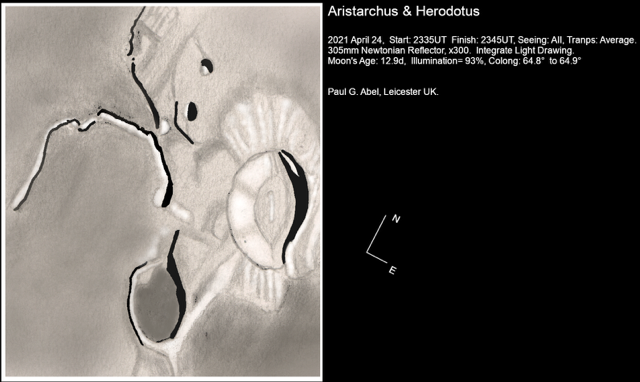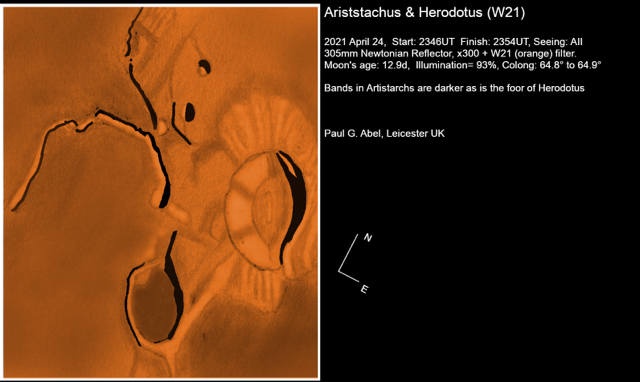Observing banded lunar craters with optical filters
2022 June 6
Here Paul outlines an observing project that does not require elaborate equipment, so is well suited to BAA members who are fairly new to lunar observing.
Introduction
On 2021 Feb 25, I was observing the Moon with my 305mm (12-inch) Newtonian reflector, with the intention of trying to visually detect any colour in the Aristarchus plateau. This plateau is the home of the splendid Aristarchus crater – a large impact formation, some 40km wide. The crater wall contains a number of dark radial bands, and these are evident when the crater is well illuminated, even in small telescopes.
I observed the region from 21:13 to 21:14 UT with a power of ×115, in good seeing (AII on the Antoniadi scale, where AI = excellent; AV = very poor). In integrated light, the bands could be seen along with some vague colour in the plateau. A much more interesting result occurred when I applied a W21 (orange) filter. The bands of Aristarchus became much darker and more prominent – the effect was rather striking and somewhat unexpected.


Naturally, I wanted to determine if this was simply a product of a specific angle of illumination, so a repeat observation was made on 2021 Apr 24 at 23:54 UT, again with my 305mm Newtonian. Once more, when viewed in the W21, the radial bands were more prominent than in ordinary light. Figures 1 & 2 are two drawings made at the time, showing the difference. These observations were reported in the Lunar Section Circular.1
The observation of banded craters using simple optical filters could be an interesting project for BAA members, especially those with modest equipment or who are fairly new to serious observing. A 90mm telescope is probably sufficient, and most telescopes are sold with a selection of filters and eyepieces. This short article describes how the project can be carried out and provides a brief introduction to filters and banded craters.
Optical filters
The BAA has a long history of promoting optical filters, primarily for use in planetary observation. An optical filter works by allowing some wavelengths of light to pass, while stopping others. It takes the form of a black ring surrounding a piece of coloured plastic. The bottom of the filter has a thread, so that it can be screwed into the eyepiece, and you will find a number printed on the side. This is the ‘Wratten number’ and it uniquely identifies the filter characteristics. (You can read more about this in Abel (2017) and Griffiths (2018).2,3)
Some commonly used filters are W15 (yellow), W21 (orange), W24A (dark red), and W47 (violet). This selection is probably enough to begin with; other Wratten variations are available from a number of shops. You can also ‘stack’ filters together to combine their effects.
Banded craters
A banded crater is one which contains one or more dark bands along the crater walls. The bands are most likely to be scree slides (accumulations of weathered rocks which form a sloping heap). A particularly fine example is the crater Aristarchus. Some examples which can be observed with a 100mm telescope are Anaxagoras, Aristillus, Birt, Bede, Burg, Conon, Dawes, Kepler, Menelaus, Proclus, Pytheas, Silberschlag and Theaetetus.
The observation of banded craters is not new. There is a nice discussion in a paper by Abineri & Lenham (1955) which classifies different types of banded crater, giving a long list of further examples and their locations on the lunar surface.4
Making observations
To observe banded craters, some degree of planning is required. The first thing to do is to make a list of the craters you wish to observe and find their location on the Moon. You will need to observe them when they are fully illuminated, so it is best to consult WinJUPOS (or any other planetarium software) to make sure the phase of the Moon means that your crater is visible.
Once you are out at the telescope and have located the crater, find a suitable magnification. Only use higher powers (greater than ×200, say) if the seeing conditions permit. Once this is done, start by examining the crater in white light – you can make an outline drawing and record the location and appearance of the bands. Make sure you record the date and time (in UT) in your drawing, along with the telescope, magnification and seeing details.
When you have finished with the white-light drawing, you can then make a filter observation. Make a careful note of any changes to the bands (and the crater walls in general) – it might be worth making another outline drawing if the changes are particularly pronounced. Again, note the date and time, as well as the filter’s Wratten number.
Try to repeat your observations over a number of different lunations to see if the appearance of the bands in different filters is constant or appears to change. Remember that the Moon’s apparent inclination is not constant; it ‘rocks’ back and forth due to libration and this changes the angle of illumination in craters from one lunation to the next. Craters near the limb of the Moon are particularly affected and may appear quite foreshortened when libration takes them closer to the limb. All of this may well affect the appearance of the crater bands.
References
1 Abel P. G., ‘The Aristarchus plateau – some filter observations’, Lunar Section Circular, 48(4) (2021 April)
2 Abel P. G., ‘Absolute Beginners No 9: Using filters for planetary observation’, J. Br. Astron. Assoc., 127(2) (2017)
3 Griffiths M., ‘Filters for visual observing of the Moon and planets’, BAA website (Tutorials section): britastro.org/tutorials (2018; accessed 2022 May)
4 Abineri K. W. & Lenham A. P., ‘Lunar banded craters’, J. Br. Astron. Assoc., 65(4) (1955)
| The British Astronomical Association supports amateur astronomers around the UK and the rest of the world. Find out more about the BAA or join us. |
